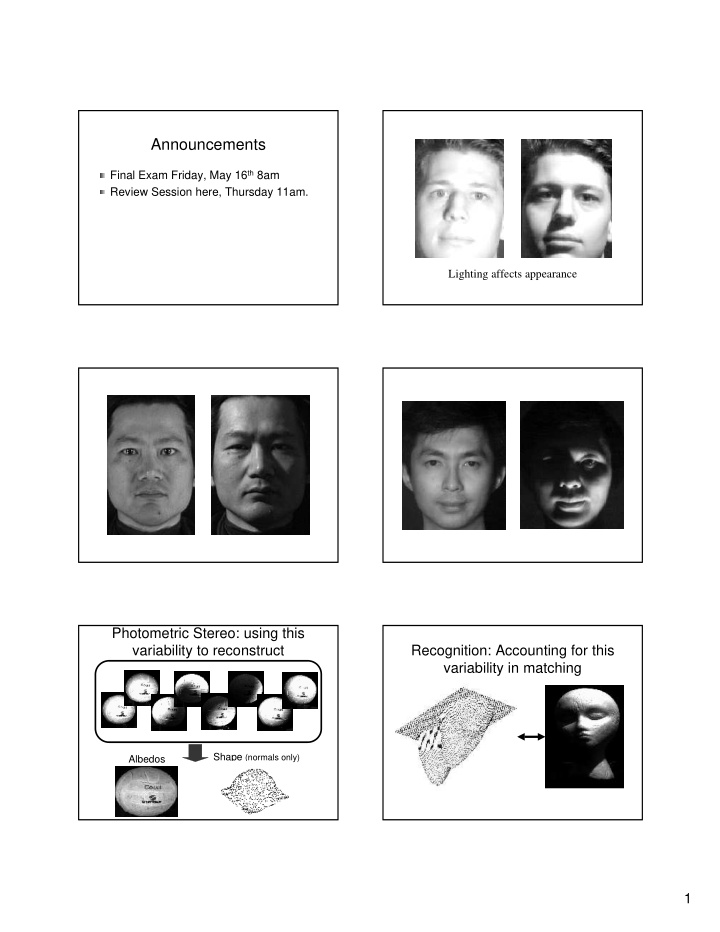



Announcements Final Exam Friday, May 16 th 8am Review Session here, Thursday 11am. Lighting affects appearance Photometric Stereo: using this variability to reconstruct Recognition: Accounting for this variability in matching Shape ( normals only) Albedos 1
Basics: How do we represent Basics: How do we represent light? (2) light? (1) Ideal distant point source: Sky - No cast shadows Environment map: l ( θ,φ) - Light distant - Light from all directions - Three parameters - Diffuse or point sources - Still distant - Example: lab with controlled - Still no cast shadows. light - Example: outdoors (sky and sun) ` Basics How do objects reflect light? Lambertian reflectance n l θ l λ max ( cos θ , 0) Reflectance map Photometric stereo Reflected light is function of surface Given reflectance map: normal: i = f( θ,φ) i = f( θ,φ) each image constrains normal to Suitable for environment map. one degree of freedom. Can be measured with calibration Given multiple images, solve at each object. point. 2
Lambertian , point sources, no Lambertian + Point Source shadows. ( Shashua , Moses) is direction of light Whiteboard l = • l l l l is intensity of light Solution linear = λ • i max( 0 , ( l n ˆ ) Linear ambiguity in recovering scaled normals i is radiance ˆ l λ is Lighting, reflectance map not known. albedo Surface ˆ Light n is surface normal Recognition by linear combinations. normal Linear basis for lighting Integrability Means we can write height: z=f(x,y). Whiteboard Reduces ambiguity to bas - relief ambiguity. Also useful in shape -from- shading and other photometric stereo. λ Z λ X λ Y Bas - relief Ambiguity Shadows Attached Shadow Cast Shadow 3
Attached Shadows With Shadows: Empirical Study (Epstein, Hallinan and Yuille ; see also Hallinan ; Belhumeur and Kriegman ) Lambertian n Ball Face Phone Parrot Environment map l #1 48.2 53.7 67.9 42.8 θ #3 94.4 90.2 88.2 76.3 #5 97.9 93.5 94.1 84.7 #7 99.1 95.3 96.3 88.5 l λ max ( cos θ , 0) #9 99.5 96.3 97.2 90.7 ± Dimension: 5 2D Reflectance Lighting Lighting to Reflectance: Intuition 1 0.5 0 0 1 2 3 Images 2 1.5 r 1 ... 0.5 0 0 1 2 3 (See D’Zmura , ‘91; Ramamoorthi and Hanrahan ‘00) 4
Models Forming Harmonic Images b (p)=?r (X,Y,Z) nm nm Find Pose Harmonic Images λ λ Z λ X λ Y Query Compare Matrix: B Vector: I 2 2 2 2 2 λ XY λ XZ λ YZ 2?(Z -X -Y ) ?(X -Y ) Experiments 3-D Models of 42 faces acquired with scanner. 30 query images for each of 10 faces ( 300 images). Pose automatically computed using manually selected features ( Blicher and Roy). Best lighting found for each model; best fitting model wins. Results 9D Linear Method: 90% correct. 9D Non - negative light: 88% correct. Ongoing work: Most errors seem due to pose problems. With better poses, results seem near 97% . 5
Summary Linear solutions are good. For pose variation with points, each image is linear combination of 2 others. For Lambertian lighting no shadows, each image is linear combination of 3. With attached shadows, linear combination of 9. Only diffuse lighting affects images, unless there are shadows or specularities . 6
This document was created with Win2PDF available at http://www.daneprairie.com. The unregistered version of Win2PDF is for evaluation or non-commercial use only.
Recommend
More recommend